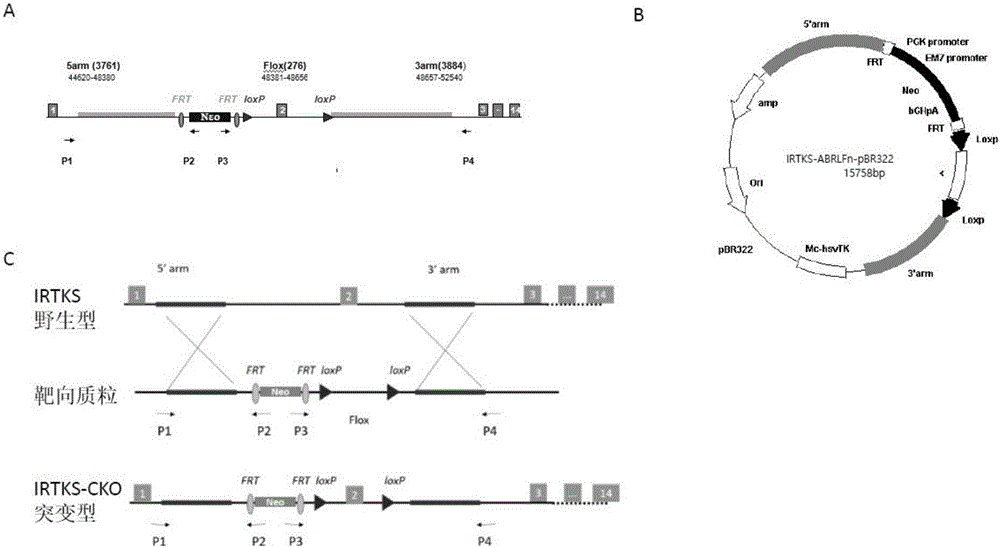Mouse model with IRTKS gene in liver specifically eliminated as well as construction and applications of mouse model
A mouse model and specific technology, applied in genetic engineering, using vectors to introduce foreign genetic material, animal/human peptides, etc., can solve the problems of human diabetes deviation, there is no animal model of human diabetes, etc., to achieve weight gain, Effects on impaired glucose tolerance
- Summary
- Abstract
- Description
- Claims
- Application Information
AI Technical Summary
Problems solved by technology
Method used
Image
Examples
Embodiment 1
[0036] Embodiment 1, the construction of IRTKS-CKO mice
[0037] 1. Construction of IRTKS-CKO plasmid
[0038] see figure 1 100μg IRTKS-ABRLFn-pBR322 targeting vector DNA was linearized with NotI (enzyme dosage: 120U), the enzyme digestion system was 200μl, digested overnight at 37°C, treated with equal volume of phenol chloroform and chloroform, precipitated with absolute ethanol, 100μl sterile Resuspend in PBS for later use.
[0039] 2. ES cell targeting and screening
[0040] The linearized plasmid of the above-mentioned IRTKS-ABRLFn-pBR322 vector was used for ES cell targeting.
[0041] ES cells: SCR012
[0042] Amount of linearized IRTKS-CKO DNA: 35 μg
[0043] Electrotransfer instrument model: Bio-Rad Gene Pulser (Cat.No.165-2105)
[0044] Electroporation conditions: voltage 240v, capacitance 500μF, actual power-on time 9.6ms, actual voltage 256v
[0045] Cloning screening conditions: 300 μg / ml G418 and 2 μM GanC selection for 8 days
[0046] A total of 96 copies...
Embodiment 2
[0067] Example 2, Genotype identification of IRTKS-LKO mice and expression identification of IRTKS
[0068] 1. Mating and breeding F1 generation mice with Alb-Cre tool mice, using PCR to identify mouse genotypes, and obtaining IRTKS-LKO mice.
[0069] First design two pairs of PCR primers, see image 3 . Primer sequences are as follows
[0070] Neo (751bp) P5: TAGTTGCCAGCCATCTGTTG (SEQ ID NO: 5)
[0071] P6: CATCCTGCACTGCTCCTGTA (SEQ ID NO: 6)
[0072] WT (497bp) P7: CTGGGGTTCCTGAGACTTTG (SEQ ID NO: 7)
[0073] P8: CATCCTGCACTGCTCCTGTA (SEQ ID NO: 8)
[0074] And Cre universal primer: (293bp) P9: AACGCTGGTTAGCACCGCAGG (SEQ ID NO: 9)
[0075] P10: TATCTCGCGCGGCTCCGACA (SEQ ID NO: 10)
[0076] PCR reaction system (50 μl): 5U / ul TaKaRa rTaq 0.25 μl, 10X TaKaRa rTaq buffer 5 μl, 2.5 mM dNTP mixture 4 μl, DNA template 300 ng, forward and reverse primers 0.3-1 μM each, sterilized distilled water to make up the total volume to 50 μl.
[0077] PCR reaction conditions: 95°C f...
Embodiment 3
[0094] Example 3. Analysis of glucose metabolism in wild-type and liver-specific knockout IRTKS mice
[0095] 1. The body weight of 5.5-month-old male mice was found to be significantly higher in liver-specific knockout IRTKS mice than in wild-type mice Figure 7 .
[0096] 2. Use Roche Accu-Chek to detect the fasting blood glucose values of IRTKS-LKO and WT mice, see the results Figure 8 . The blood glucose of IRTKS-LKO mice was significantly higher than that of WT.
[0097] 3. Male mice at the age of 5.5 months were fasted overnight and injected 1.5g / kg of glucose intraperitoneally with a 1ml syringe. Mouse blood glucose value, calculate the average value and standard deviation of mouse blood glucose at each time point, and carry out student's t-test statistical analysis, with the time point as the abscissa, the blood glucose value as the ordinate, and the standard deviation as the error value, draw Glucose Tolerance Curve, see results Figure 9 .
[0098] 4. Live...
PUM
 Login to View More
Login to View More Abstract
Description
Claims
Application Information
 Login to View More
Login to View More - R&D
- Intellectual Property
- Life Sciences
- Materials
- Tech Scout
- Unparalleled Data Quality
- Higher Quality Content
- 60% Fewer Hallucinations
Browse by: Latest US Patents, China's latest patents, Technical Efficacy Thesaurus, Application Domain, Technology Topic, Popular Technical Reports.
© 2025 PatSnap. All rights reserved.Legal|Privacy policy|Modern Slavery Act Transparency Statement|Sitemap|About US| Contact US: help@patsnap.com



